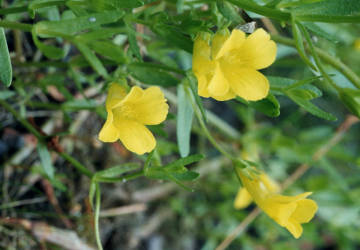Nature Notes

PHOTO COURTESY OF GARRY KESSLER
Close-up of small golden hedge-hyssop blossoms that grow on sandy shores.
August 17, 2022
NATURE NOTES
By Annie Reid
Westborough Community Land Trust
A Trip to the Shore
A trip to the shore, usually an ocean shore, is family fun in mid- to late summer. This year’s drought has created a more local option: muddy or sandy inland shores exposed by receding waters in many local ponds and streams. These shores invite exploration.
Have you noticed shores that used to be hidden under water but now are covered with a profusion of small yellow blossoms? Where did those flowers come from, all of a sudden? Called golden hedge-hyssop (Gratiola aurea) or golden pert, these plants have been there all along, but in a different form. Under water, they exist as small aquatic plants, about half an inch high, with tiny leaves, hardly noticeable. But now uncovered on sandy shores and getting full sunlight, these plants grow larger and bloom in their land-based form. They’re 4-12 inches high, with leaves up to an inch long, and half-inch tubular yellow blossoms. Not all plants can live both under water and on land, as these do.

PHOTO COURTESY OF GARRY KESSLER
Pincushion-like flowerheads of button bush attract pollinators near the water’s edge.
Walking near a shore, you might discover button bush (Cephalanthus occidentalis) with its unique round, white flowerheads that look like pincushions. These 1- to 2-inch flowerheads attract pollinators such as bees, butterflies, and hummingbirds. (The “pins” that stick out are the female, pollen-receiving parts of the flowers in the flowerhead.) In fall, the flowerheads become reddish seedheads with dry button-like fruits that give the bush its name. Ducks and shorebirds like to eat the buttons. Deer feed on its twigs in winter.
Button bush can get 12 feet high and “likes wet feet,” so it thrives right next to water. If you’ve fished from shore in wetter years, you may have done so while standing next to a button bush. It’s sometimes used in wetland restoration projects to prevent soil erosion. For gardeners, it has been suggested for rain gardens and as a native alternative to non-native butterfly bushes (Buddleja).
Walk on a recently exposed shore and you might see that you’re not the only visitor. Tracks of deer and hand-like prints of raccoons reveal night-time visits by these animals. Peer into the shallows and you might spy a turtle or a water snake (nothing to fear).

PHOTO COURTESY OF GARRY KESSLER
Green herons fish in shallow water.
Birds often provide the best show. Look for our local herons, perhaps a 4-foot-tall great blue heron (Ardea herodias) standing or walking slowly in the water to hunt fish and frogs. You might notice one or several crow-sized green herons (Butorides virescens) fishing at the water’s edge. At this time of year, young green herons follow their parents for a month or more, learning to fish and fend for themselves. Green herons are somewhat famous as “tool-users” because they sometimes bait fish by placing things such as leaves, insects, or feathers on the water. You’d be really lucky to see this. More likely, you’ll see young herons striking at small fish and missing. (Watch this video of a green heron learning to fish https://youtu.be/4gDh9Je6RUU )
A shore is a shore, even if it’s not there every year, so it’s no surprise – and a real treat – if some migrating shorebirds show up. They’ll take advantage of a temporary shore to refuel on their way south after breeding farther north.

PHOTO COURTESY OF GARRY KESSLER
Solitary sandpipers hunt insects and tiny fish along temporary shores.
For example, you might spot a solitary sandpiper (Tringa solitaria), about the size of a robin and well camouflaged on a muddy shore by brown and white colors. This bird makes a long trek south from breeding grounds in Canada or Alaska to wintering grounds in Mexico or Central or South America. Solitary sandpipers tend to travel alone, rather than in flocks. They hunt insects, tiny fish, snails, and more. Ducks, killdeer, and various shorebirds might also stop by, including least sandpipers (Calidris minutilla), nearly as small as sparrows. They probe the mud for prey.
There’s probably no swim for the kids at inland shores, but there’s the fun of finding out what’s there in an environment that isn’t always there. Look for these shores as you walk or drive around, and enjoy nature’s changes.